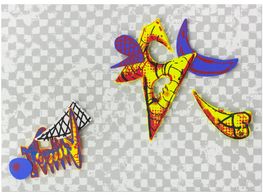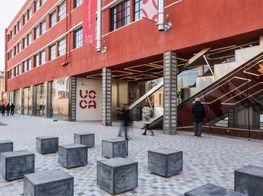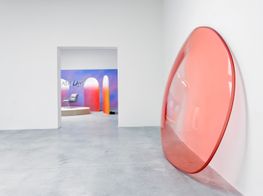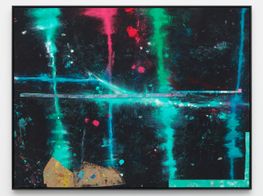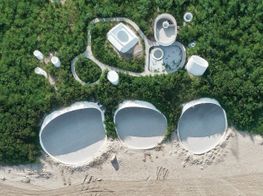Finding The Desert In The Desert: The Los Angeles Project At Ucca, Beijing
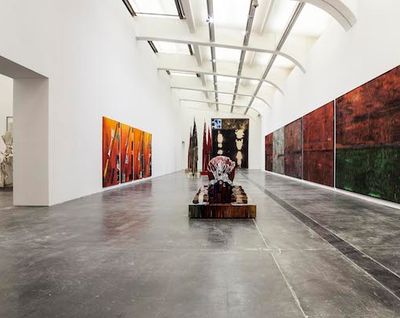
Ask a Beijing artist where they would like to spend time abroad living, working, seeing exhibitions, meeting artists and curators, and the answer is invariably New York. Aside from the obvious attractions, New York appears culturally exotic; there seems to be a consensus that Beijing, as an art center and urban environment, operates somehow more like Los Angeles: everyone drives everywhere; the air has a history of haze; people have large living spaces; street life is a localized afterthought.
The stereotype is that, in cities like Shanghai and New York, the eccentric edges of character are ground down; whereas in Beijing or Los Angeles, relative isolation breeds individual quirks. Seven such individual practices are currently the subject of The Los Angeles Project, an exhibition spanning the whole of Beijing’s Ullens Center for Contemporary Art.
The viewer first encounters a series of wall paintings Alex Israel commissioned for execution by technically proficient local muralists. Depicting props belonging to the Warner Brothers studio, the result is a sunlit corridor of objects that appear to depict a pleasant Californian street but, in fact, constitute a representation of a representation of such a street: parking meters, trailers, and director chairs. Israel often works with various Hollywood production systems, creating paintings that are completed according to the scheduling exigencies of production studios and borrowing props for exhibition as sculpture that are then returned to the studio. Unmoored from this cultural geography, the paintings in Beijing are lonely, fantastic, and perhaps a little desperate for company.
Doubling back into a maze of dead ends and narrow corridors, the viewer then discovers Kaari Upson’s Larry Project, here consisting largely of silicon molded into the forms of mattresses, sofas, chairs, and a six-pack. What emerges is a tense eroticism that appears more threatening than exciting; Upson catalogues the traces of the body in such a way that even the most sensual device—prints of Angelina Jolie’s lipstick, in this case—becomes a mark of sin (if a morally relative one) more than an invitation. One imagines these once-upholstered objects, brightly colored and flaccid as they are, as the shrugging corpses of masculinity propped up by a curiosity and alienation rather than lust or affection.
Sterling Ruby appears at the next corner with far and away the most significant presentation within this exhibition: 30 meters of spray paintings line one wall, bookended on the facing walls with enormous tapestries some seven meters tall. The space between is occupied by Monumental Stalagmites, the dripping cones around double human scale that appear as rockets or missiles grown directly out of the earth. One lies on its side, a massive trunk of decaying urethane; its rear end, mottled like a dried lotus bulb, is like a gutted engine, a threat of speed and heat that never comes to pass. There is a lot of Ruby around Asia right now: a viewer on the right junket might see his ovens in Gwangju, paintings and Raf Simon garments in Hong Kong, works on paper in Taipei, and quilt paintings in Tokyo. Working in large cycles across multiple technically demanding media in a way that is directly based in the urban aesthetics and fabrication possibilities of his neighborhoods, he is, perhaps, the most Beijing of American artists.
One may choose to leave Ruby’s gritty post-minimalist gallery through either of two exits, both of which lead to presentations interested in the wild, fauvist side of modernism. Matthew Monahan is the more restrained of the two, offering a tight salon of charcoal drawings, classical sculptures on plinths, reconceived to blur the distinction between art object and furniture, while also infusing the figures with a burst of animism. In this space, the only black and white gallery in the exhibition, one realises for the first time that Los Angeles art, as presented here, is as much about art as about Los Angeles; this realisation pulls the viewer back through galleries already visited with a more formal eye.
Choosing the other exit or proceeding onward, the viewer finds the sexier, youthful side of these same incursions into modernist primitivism. Aaron Curry offers five soaring sculptures from his core ongoing practice; whereas many of his forms recall the human body, here is something more alien or prehistoric: in one moment ribcages duck close to the ground, while in another disjointed limbs reach for the sky. Treating his exhibition space in the most inventive way, Curry covers the walls with more than 200 sheets of cardboard sprayed haphazardly with bright orange pigment, occasionally interrupted by found objects like crushed cans and honeycombs. The overall effect is one of organic rebirth within a post-apocalyptic future, a scenario experienced by both Beijing and Los Angeles over the past half-century.
Leaving the main space of the museum, Ryan Trecartin installs his Any Ever video cycle in a low-slung room with raised corporate carpeting. Each piece is viewed on different furniture: a home theater set-up, a pair of bed frames, a round meeting table, and standard office sofas. The viewer moves backwards in time, from some of the highest production value work, dominated by supremely cheesy visual effects, to a purer, more frenetic form of acting and presence as production. As soundtracks and images bleed into one another the message remains clear; this is a singular body of work as clean and considered as any. Trecartin, as the phrase goes, may not be the voice of his generation, but he is certainly a voice of a generation.
Entering the final gallery, parallel to Alex Israel’s murals, the viewer finds herself in a long space, each wall transformed into one of the red-stockinged legs of Mrs. Robinson in The Graduate. Kathryn Andrews inserts her work into this architectural Electra complex in the form of several metallic canisters plastered with altered likenesses of Bozo the Clown. Drawing on several adjacent moments from popular culture, Andrews seems to most thoroughly inhabit the media space of mainstream America; her work represents the bizarre interpretation of the universal rather than the universalizing of individual eccentricity.
Aside from these seven individual galleries, each practice is also presented in an individual artist book; Beijing clearly understands the need to keep people separated in their own bubbles, whatever the motive. What is most surprising about “The Los Angeles Project,” perhaps, is not how well the work fits into Beijing’s artistic and natural ecologies but rather the specific points at which it departs from our understanding of art today: virtually all of these projects draw heavily on one or two medium-specific discourses, and approach various traditions of figurative representation—two strategies that are anathema to the Beijing creative consensus.—[O]

